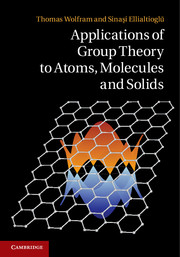Book contents
- Frontmatter
- Contents
- Preface
- 1 Introductory example: Squarene
- 2 Molecular vibrations of isotopically substituted AB2 molecules
- 3 Spherical symmetry and the full rotation group
- 4 Crystal-field theory
- 5 Electron spin and angular momentum
- 6 Molecular electronic structure: The LCAO model
- 7 Electronic states of diatomic molecules
- 8 Transition-metal complexes
- 9 Space groups and crystalline solids
- 10 Application of space-group theory: Energy bands for the perovskite structure
- 11 Applications of space-group theory: Lattice vibration
- 12 Time reversal and magnetic groups
- 13 Graphene
- 14 Carbon nanotubes
- Appendix A Vectors and matrices
- Appendix B Basics of point-group theory
- Appendix C Character tables for point groups
- Appendix D Tensors, vectors, and equivalent electrons
- Appendix E The octahedral group, O and Oh
- Appendix F The tetrahedral group, Td
- Appendix G Identifying point groups
- Index
- References
2 - Molecular vibrations of isotopically substituted AB2 molecules
Published online by Cambridge University Press: 18 December 2013
- Frontmatter
- Contents
- Preface
- 1 Introductory example: Squarene
- 2 Molecular vibrations of isotopically substituted AB2 molecules
- 3 Spherical symmetry and the full rotation group
- 4 Crystal-field theory
- 5 Electron spin and angular momentum
- 6 Molecular electronic structure: The LCAO model
- 7 Electronic states of diatomic molecules
- 8 Transition-metal complexes
- 9 Space groups and crystalline solids
- 10 Application of space-group theory: Energy bands for the perovskite structure
- 11 Applications of space-group theory: Lattice vibration
- 12 Time reversal and magnetic groups
- 13 Graphene
- 14 Carbon nanotubes
- Appendix A Vectors and matrices
- Appendix B Basics of point-group theory
- Appendix C Character tables for point groups
- Appendix D Tensors, vectors, and equivalent electrons
- Appendix E The octahedral group, O and Oh
- Appendix F The tetrahedral group, Td
- Appendix G Identifying point groups
- Index
- References
Summary
In this chapter we illustrate how group theory can be used to find the normal mode frequencies of isotopically substituted molecules. We consider triatomic molecules of the AB2 type with isotopic substitutions for either the A atom or the B atom, or both. In particular, we analyze and derive numerical results for H2O when deuterium or tritium is substituted for hydrogen and when 18O is substituted for 16O. We begin by analyzing the vibrational modes of the AB2 molecule, and then go on to discuss the vibrational modes of isotopically substituted AB2 molecules.
Step 1: Identify the point group and its symmetry operations
A schematic representation of an AB2 molecule is shown in Fig. 2.1(a). In two dimensions the only symmetry operations are the identity, E, and 180-degree rotation about an axis through the A site, bisecting the B–B line. Reflection in the line of the C2 axis gives the same result as C2 in two dimensions. The group is C2. In three dimensions, the elements include C2, a reflection in the plane perpendicular to the plane of the paper and containing the C2 axis, σv, and reflection in the plane of the paper,σ′v. In three dimensions the group is C2v. Since the AB2 molecule has no out-of-plane vibrational modes (Exercise 1.15), we shall use the smaller C2 group for analysis.
- Type
- Chapter
- Information
- Publisher: Cambridge University PressPrint publication year: 2014



